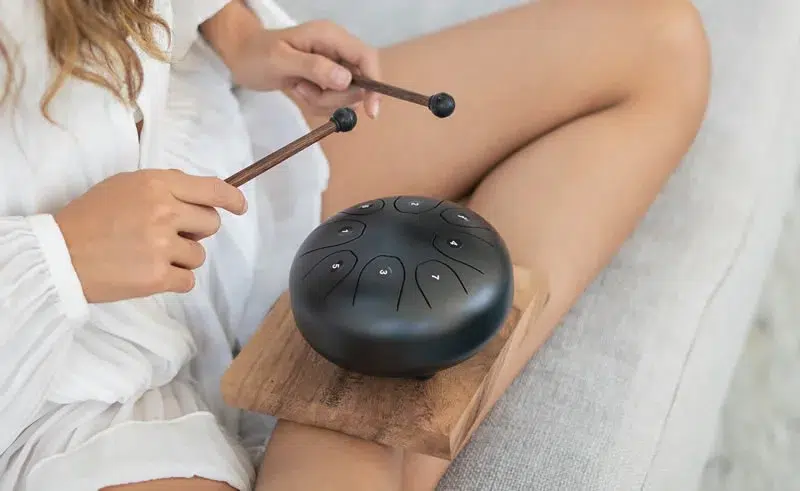If you’ve recently acquired a steel tongue drum, you may be wondering if you can play it using your hands.
The answer is yes, and it offers a unique playing experience that you won’t get from using mallets or drumsticks. Playing a steel tongue drum with your hands can be a challenging and rewarding experience, and it allows for a greater range of playing techniques.
In this article, we’ll explore the various hand techniques for playing and provide you with a step-by-step guide on how to play it with your bare hands. We’ll also cover the advantages of hand playing and provide tips and tricks for mastering this unique style of percussion.

Key Takeaways:
- Playing a drum with your hands is possible and offers a unique playing experience.
- That allows for a greater range of playing techniques that are not possible with mallets or drumsticks.
Content
Exploring Hand Techniques for Playing a Steel Tongue Drum
Hand playing on a steel tongue drum requires the use of hand movements, wrist actions, and finger placements to produce sound.
There are several techniques you can use to enhance your hand-playing experience, depending on your level of skill and preference.
The following is a comprehensive list of hand techniques you can use to play:
| Technique | Description |
|---|---|
| Slaps | Use your thumb to roll or flick across the tongues in quick succession, producing a rapid succession of notes. This technique is great for playing fast rhythms or creating rhythmic patterns. |
| Palm Mutes | Using the fleshy part of your palm to dampen the vibration of a tongue, producing a muted sound. This technique is great for creating a softer, more delicate sound. |
| Finger Plucks | Plucking the tongues using your fingers to produce a bright, bell-like sound. This technique is great for creating melodic lines and playing chords. |
| Thumb Rolls and Flicks | Placing your hand flat on the drum’s surface, then gently drag your hand across the tongues to produce a sweeping sound. This technique is great for creating atmospheric soundscapes. |
| Hand Drags | Placing your hand flat on the drum’s surface, then gently dragging your hand across the tongues to produce a sweeping sound. This technique is great for creating atmospheric soundscapes. |
With a little bit of practice, you’ll soon be able to create beautiful melodies, complex rhythms, and a range of dynamic sounds using only your hands.
The Art of Playing with Hands
Follow these simple steps to master the art of playing a drum using only your hands:
- Start by finding a comfortable position where you can balance the drum on your lap, or on a stand if you prefer a standing position. Use your feet to secure the drum if necessary.
- Place your hands flat on the drum, with your fingers spread out evenly. Start by striking the drum in the center with the tips of your fingers. Experiment with the amount of force you apply to the drum and try different finger positions to achieve different tones.
- Explore the sound range of the drum by moving your hands around to different areas of the drum. The edges of the drum often produce higher-pitched sounds, while the center produces low-pitched sounds.
- Try playing the drum with just one hand at a time, or alternate between both hands to create rhythm and variation.
- Experiment with different hand techniques, such as slaps, taps, and finger rolls. Use the surface of your fingers, your knuckles, or the pads of your palms to create a range of sounds and textures.
- Listen carefully to the sounds you produce and adjust your technique accordingly. With practice, you will be able to create complex rhythms and melodies using just your hands.
- Remember to take breaks frequently to avoid overstraining your hands and wrists. Playing a steel tongue drum can be a meditative and relaxing activity, so don’t rush the learning process.
Whether you’re a beginner or an experienced musician, this technique allows for endless possibilities for creative expression.
Advantages of Hand Playing on a Steel Tongue Drum

If you are a music enthusiast, you know that the quality of sound produced depends largely on the playing technique and the instrument used.
This type of drum is a unique and versatile musical instrument that can be played in various ways.
Here are some advantages:
| Advantages | Description |
|---|---|
| Increased Control | You have better control over the sound produced. Your fingers can easily adjust the pressure applied to the drum, which affects the pitch and volume of the sound. This level of control is not easily achieved when using mallets or other playing tools. |
| Greater Sensitivity | Hands allow you to feel the vibrations produced by the instrument. This sensitivity enhances your playing experience and allows you to create a deep connection with the instrument. |
| More Expressive | You can use your fingertips and palms to explore different playing techniques, including tapping, gliding, and bending. The result is a more unique and personal playing style that cannot be achieved with other playing tools. |
| Accessible | You do not need any special skills or equipment to get started. All you need is your fingers and a willingness to explore. |
So why not give it a try and see what unique sounds you can create?
Hand-Playing Techniques
Playing a steel tongue drum with your hands requires a specific set of techniques to produce the best sounds.
Here are some steel tongue drum hand playing techniques you can try:
- Finger tapping: Start by tapping the steel tongues with your fingers, alternating between your index and middle fingers. Begin with the middle of the steel tongue and move towards the edge. This technique produces a clear, sharp sound.
- Sliding: Slide your fingers along the length of the steel tongue while applying pressure to produce a smooth, gliding sound. Try sliding your fingers both up and down the steel tongue for different effects.
- Thumb rolling: Use your thumbs to roll along the surface of the steel tongue. This technique produces a mellow and resonant sound that is perfect for slower melodies.
These techniques can be combined and modified to produce a wide variety of sounds and rhythms.
Experimenting with different techniques is the best way to find your own unique sound and style.
Additional Tips:
- Try using different parts of your hand, such as the palm or heel, to strike the steel tongue and produce different sounds.
- Adjust the pressure and speed of your strikes to vary the volume and tone of the sound.
- Practice regularly to improve your technique and develop muscle memory.
Remember, playing a steel tongue drum with your hands is all about personal expression and creativity. Use these techniques as a starting point and let your imagination lead you to new sounds and rhythms.
Tips for Mastery in Hand (Finger) Playing
If you want to master the art of playing with your fingers, the key is practice and patience. Here are some tips to help you along your journey:
- Start slow and steady: Don’t rush into playing complex rhythms right away. Start with simple patterns and gradually increase the tempo as you become more comfortable.
- Focus on relaxation: Pay attention to your posture, loosen up your shoulders, arms, and hands, and allow the rhythm to flow naturally.
- Experiment with different hand positions: Try playing with your fingertips, knuckles, or palms. Each technique produces a unique sound, so don’t be afraid to mix things up.
- Listen to the sound: Be attentive to the sound of your drum. Listen for each note and try to produce a clear, consistent sound with each strike.
Remember, developing a skill takes time and patience. Don’t be discouraged if you don’t get it right away.
Conclusion
Playing a steel tongue drum with your hands is not only possible but can also enhance the experience of creating music with this unique instrument.
You can use your fingers, palms, and even your knuckles to create a variety of sounds and tones, making the music you create truly unique.
I hope this article has inspired you to explore this unique musical instrument and discover the joy of hand playing on a steel tongue drum.
FAQ
What are some hand techniques for playing a steel tongue drum?
There are several hand techniques that can be used to play a steel tongue drum, such as tapping, slapping, and using fingertips.
Are there any specific hand-playing techniques for a tongue drum?
These techniques include finger rolls, palm strikes, and using the side of your hand to create different sounds and effects.
Best tips for mastering hand-playing
Practice regularly, experiment with different techniques, and focus on developing a sense of rhythm and control to master hand playing on a steel tongue drum.
